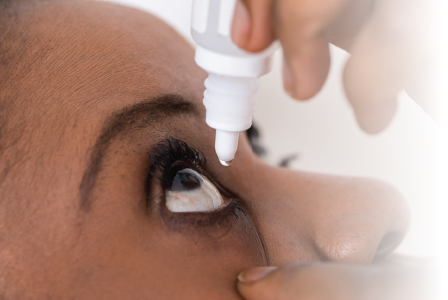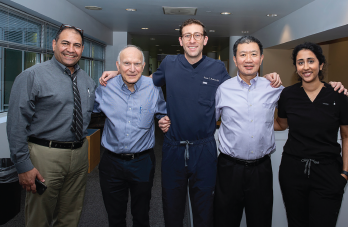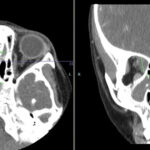
Andrey_Popov / shutterstock.com
When my daughter was a second-year internal medicine resident at Massachusetts General Hospital, Boston, she called me excitedly one evening. “Dad,” she reported, “I think I saw the optic nerve for the first time today with an ophthalmoscope.” I suppose I should have shared her exuberance, except that when I went to medical school, a pharmaceutical company gifted us an ophthalmoscope on our first day. Along with our reflex hammer and tuning fork, it was an essential emblem of the trade.
Today, if you’re making rounds in the hospital and you request an ophthalmoscope, you are regarded warily and probably told that no such tool is available. Medical training has changed; my daughter was a victim of the times because it really is true that many clues to disease outside the eye can be gained by ophthalmoscopy. (P.S., I hope my daughter will forgive me for sharing this story; my wife and I are each immensely proud of the professional accomplishments of both our physician-daughters.)
As rheumatologists, many of us chose the field because we believe we are the Sherlock Holmeses of internal medicine. We delight in being challenged by complex medical mysteries. But we have our limits. A good detective should know when to seek the expertise of another specialist.
Many of us also selected rheumatology because it demands that we understand every organ system in the body. No tissue can escape potential attack by the immune system. But for most of us, another physician probably knows more than we do about the heart, the brain, the lung, the kidney, the skin or the eye. Once upon a time, you trained to be a cardiologist. Now, cardiology has perhaps 20 subspecialties. And within rheumatology, we recognize practitioners who have special expertise in lupus, scleroderma, psoriatic arthritis, gout. I’m sure you understand my point even if I don’t list every conceivable disease seen by a rheumatologist.
Interdisciplinary Clinics
Like many academic centers throughout the world, my division has established interdisciplinary clinics. Rheumatology at Oregon Health & Science University (OHSU), Portland, partners with dermatology, pulmonary, neurology and ophthalmology. And we need a similar clinic with nephrology. Other institutions collaborate to care for patients with regional problems, such as hand disease. Sports medicine, cardiology, fibromyalgia and gastroenterology represent opportunities for collaboration.
These types of clinics optimize patient care because communication is greatly facilitated. These types of clinics are ideal for teaching because the trainee is exposed to at least two perspectives that presumably are being offered by experts. These types of clinics are ideal for research because patients with similar conditions can be seen in a volume to allow for meaningful insights. And these types of clinics provide the ultimate in convenience for the patient because no delay is experienced in referring to the second specialist.
Partnership with Oculoplastic Surgery

The authors, who comprise the OHSU Rheumatology-Oculoplastics Orbital Clinic. From left: Hadi Khazaei, James T. Rosenbaum, Davin C. Ashraf, John D. Ng, Shravani Mikkilineni.
With these thoughts in mind, OHSU has initiated what we believe to be a unique interdisciplinary clinic, a partnership between rheumatology and oculoplastic surgery. Such a collaboration may seem unnecessary, but oculoplastic surgeons care for diseases of the orbit, many of which are immune-mediated. These diseases include orbitopathy secondary to thyroid eye disease, sarcoidosis, IgG4 disease, anti-neutrophil cytoplasmic antibody (ANCA) associated vasculitis and non-specific orbital inflammation, which my colleagues and I contend is often a limited form of ANCA-associated vasculitis.
I don’t know a rheumatologist who can use a Hertel exophthalmometer. I think it’s a safe bet that most rheumatologists need help interpreting orbital imaging. But it’s also a safe bet that an oculoplastics doctor would rather be in an operating room than ordering immunosuppression for ANCA-associated vasculitis.
We started this collaboration just four months ago at the time of this writing. We hold an interdisciplinary clinic for a half day, once per month. But we are already oversubscribed. Our patients have included two 6-year-olds with possible IgG4 disease, many patients with thyroid eye disease who are candidates to receive the monoclonal antibody teprotumumab, a patient seeking a second opinion for refractory disease despite multiple infusions of a biologic, and a patient carrying a diagnosis of IgG4 disease whose collection of symptoms suggested the underlying diagnosis might actually be eosinophilic granulomatosis with polyangiitis.
The concept of an interdisciplinary clinic is simple. The execution can be complex. Which doctor takes primary responsibility for the patient’s care? Which doctor responds to electronically submitted questions or phone calls? Which doctor or which office completes the prior authorization forms? Which doctor or which office answers the refill requests? Perhaps most importantly, how is billing divided?
Because the clinic selects for patients who would normally see two different specialists, submitting two bills for the same day of service is appropriate, but patients need to expect and understand this billing structure and appreciate that they are benefiting by virtue of convenience, improved communication and prompter scheduling of consultation. For doctors, the involved personalities need to complement each other and recognize the value of the gestalt (i.e., together they are more than the sum of the parts).
I have been a rheumatologist for 40 years. Knowledge and improving therapeutics have made our profession increasingly gratifying and popular. Working with a colleague whose knowledge is complementary to one’s own is a great opportunity to enhance our skills and achieve more for our patients. Co-management and learning from one’s colleagues are luxuries I can recommend with confidence.
James T. Rosenbaum, MD, Shravani Mikkilineni, MD, MBA, Hadi Khazaei, MD, Davin C. Ashraf, MD, and John D. Ng, MD, MS, FACS, are affiliated with the Casey Eye Institute, Oregon Health & Science University, Portland. Dr. Rosenbaum is also affiliated with the Legacy Devers Eye Institute, Portland.
*A note about authorship: This essay was written in the first person by Dr. Rosenbaum. However, it could not have been written without the four collaborating orbital surgeons who made the clinic possible and who each reviewed and contributed to the content.
Disclosures
Dr. Rosenbaum is a consultant for AbbVie, Gilead Sciences, Novartis, Revolo Biotherapeutics, Corvus Pharmaceuticals and Horizon Therapeutics. He has also received trial support from Horizon and Pfizer, and royalties from Up-to-Date. He has performed data monitoring for Celgene and BMS.
Dr. Ashraf has received support from Horizon for clinical trials.
Dr. Ng served as the primary investigator on clinical trials that received support from Horizon. He is also a shareholder in BioLogic, Aqua Research.


